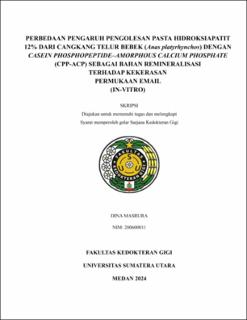Perbedaan Pengaruh Pengolesan Pasta Hidroksiapatit 12% dari Cangkang Telur Bebek (Anas platyrhynchos) dengan Casein Phosphopeptide–Amorphous Calcium Phosphate (CPP-ACP) sebagai Bahan Remineralisasi terhadap Kekerasan Permukaan Email (In-Vitro)
Differences in The Effect of Applying 12% Hydroxyapatite Paste from Duck Eggshell (Anas Platyrhynchos) with Casein Phosphopeptide-Amorphous Calcium Phosphate (CPP-ACP) as a Remineralization Agent on Enamel Surface Hardness (In-Vitro)
Abstract
Dental caries is an infectious disease that damages hard tooth tissue and causes health problems for both developed and developing countries. Dental caries occurs due to interactions between bacteria in the oral cavity and carbohydrate components. Carbohydrates from food waste will be fermented by bacteria which can trigger demineralization of the tooth surface, especially the enamel layer. Mineral loss accompanied by a decrease in enamel surface hardness can be inhibited through the remineralization process. One ingredient that can be used as a remineralization agent is duck egg shell which contains 95% calcium carbonate.
The aim of this research was to determine the difference in the effect of applying 12% hydroxyapatite paste from duck egg shells (Anas platyrhynchos) compared to Casein Phosphopeptide - Amorphous Calcium Phosphate (CPP-ACP) paste as a remineralization agent on enamel surface hardness. This study used 24 samples of maxillary first premolars that had been extracted. The entire sample was divided randomly into four treatment groups, namely groups I, II, III, and IV. Group I was demineralized with HCl and 12% duck egg shell hydroxyapatite paste was applied for 30 minutes, group II was demineralized with HCl and CPP-ACP test material was applied for 30 minutes, group III was demineralized with HCl without the test material, group IV was not demineralized and were not given test materials. The four groups were soaked in artificial saliva and kept in an incubator at 37oC. The procedure was repeated for 14 consecutive days. Testing the enamel surface hardness with the Microvickers Hardness Tester was carried out 2 times, namely after the demineralization process and after administering the test material.
The results of the paired t-test showed that there was a significant increase in enamel surface hardness in all groups with p<0.05. From the results of the one-way ANOVA statistical test, the value of p=0.0001 is obtained, where p<0.05 indicates that there is a significant difference in influence between the four groups. Post Hoc LSD statistical results showed significant differences between all groups with p<0.05. The group that had the most significant difference was group I (PCT 12% for 30 minutes) and group IV (control) where p=0.0001. Based on the research results, it can be concluded that there is a significant difference between 12% duck eggshell hydroxyapatite paste, CPP-ACP and artificial saliva in increasing the surface hardness of tooth enamel. The largest increase in enamel surface hardness value was obtained when applying 12% hydroxyapatite paste from duck egg shells.
Collections
- Undergraduate Theses [1901]

